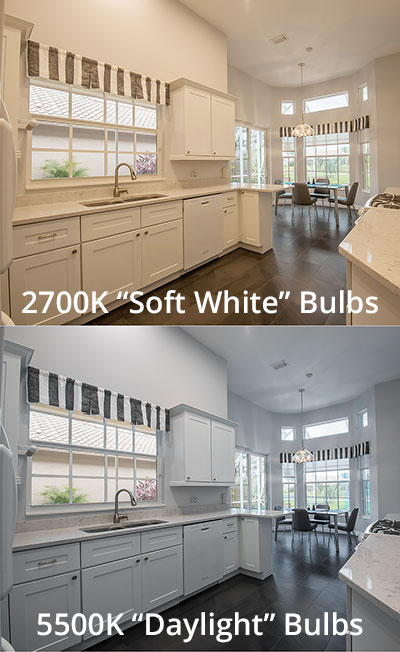(561) 406 8020
info@immersivespaces.co
PO Box 2448 Palm Beach FL 33480
You’ve spent time creating the perfectly staged listing; you’ve selected the latest trend in accent colors, the exact furniture positions, and even the perfect wall color. The sunlight shines perfectly across a room that looks like it should be on the cover of a beach living magazine. After hours of preparation, your listing is “photo-ready,” …but is it??? Have you considered the lighting of your property?
Often overlooked in spaces is lighting and how it can change the impression and mood of your decorated masterpiece of modern living. Have you ever noticed that warm, golden glow that comes from the windows of a home at night? How about that clean, crisp white light in the jewelry store or dentist office? How do those light colors affect the mood of those spaces? Knowing what that color of lighting does in various rooms throughout your property, and what the psychological “meaning” those colors can be a valuable tool in preparing your listing for showings and photography.

Before the arrival of the compact fluorescent tube and LED lighting, the color of the light was essentially measured by the temperature of the filament in a light bulb expressed in degrees Kelvin. A low-temperature bulb resulted in a light that had a red or orange hue while a higher temperature bulb resulted in a light that had a bright white or blue tint. Since many modern light sources create light through processes other than thermal radiation, they are assigned a degrees Kelvin equivalent called the Correlated Color Temperature (CCT). The CCT measurements used by modern light manufacturers are a human color perception equivalent that most closely matches the color perceived rather than the actual color temperature of a light source. Often manufacturers will list the visual temperature of the bulb as perceived under the CCT. The higher the number, the brighter and whiter the light will become.

Since most homeowners spend time in their homes in the evening hours, the natural trend in lighting has been towards a warm incandescent light glow that measures between 2400 K and 2700 K. This lighting is often called “soft white” and is the most common lighting found in modern homes. This temperature lighting is what is responsible for the orange glow that emanates from dwellings at night and is perceived psychologically as “comfortable” or “cozy.” During daytime hours, the use of lights with this color temperature range has a yellowing effect on the environment that is perceived as being “hot,” or “old.” If trying to create an optimum selling environment, having a home perceived as “old” or “hot” during a Florida summer is probably a less than ideal situation.
On a clear day at noon, the sun shines at a temperature of roughly 5780 K. As the sun moves across the sky from morning to night, its color temperature will range from very warm in the morning and evening hours to its coldest point at midday. So why is this important to understand? For starters, most home showings take place during the daylight hours, and statistically, most fall in the early afternoon hours. Knowing this allows us to create a lighting plan that best takes advantage of exterior and interior light temperatures. To put it simply, if it’s bright and cool light outdoors, we want to come as close as possible to matching that light temperature indoors to create a space that flows from room to room and into any outdoor living spaces. The balanced lighting gives the impression that everything fits together cohesively.
Now, unfortunately, most people don’t have an endless supply of light bulbs at various temperatures to switch out throughout the day as the color temperature changes outside, so the goal is to create a lighting palette that is most favorable for the most hours of the day. While every home in every location will vary slightly, a general rule of thumb is to light your home with bulbs in the 5000 K to 5500 K temperature range to accommodate showings and photography during daylight hours. Showings in the early or late hours of the day will appear slightly cooler, and those more in the middle of the day will appear more comparable to the outside light created by the sun. Trending more towards 5000 K will give you the largest window of viewing times before the environment starts appearing “cold.”
Remember, each space has its unique characteristics and strengths. When lighting your room, use it to highlight the strong points and wash away the less desirable ones. Lights should never distract from the space but enhance it. Keeping it consistent and bright will have the most significant impact on potential buyers.

Every Day Is An Open House!™

© 2023 Immersive Spaces, LLC. All Rights Reserved.
